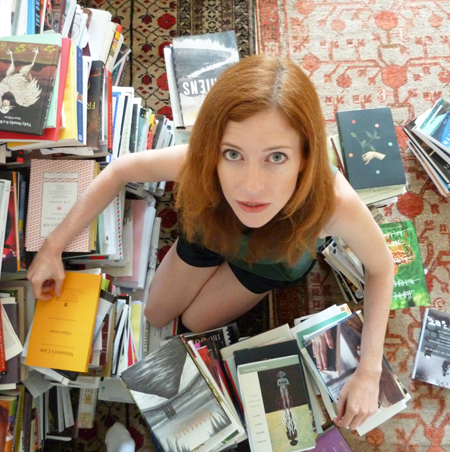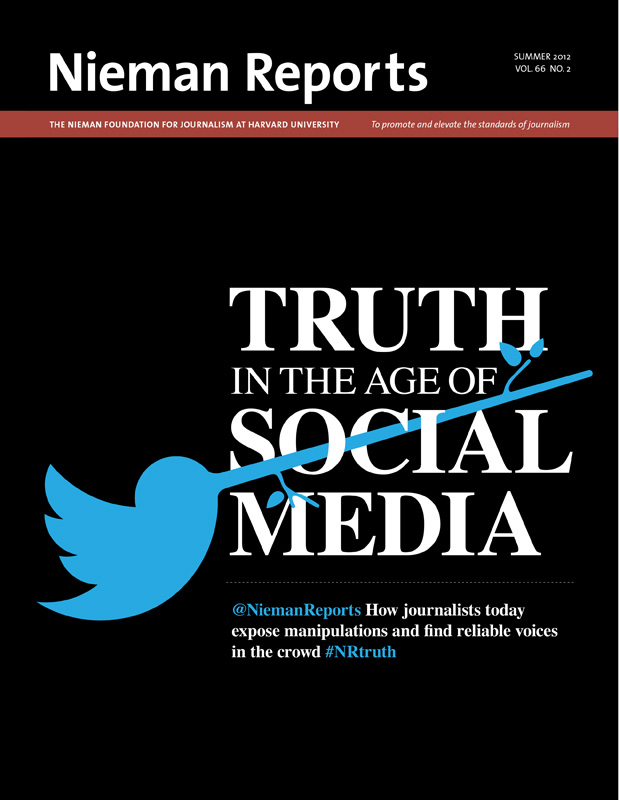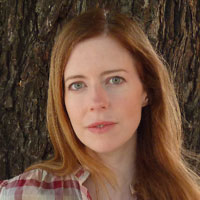
Vogue contributing editor Megan O’Grady, a 2012 Nieman Fellow. Photo by Thorsten Trimpop.
One lesson we learn young is that there’s a public life and a private narrative, and the two don’t always correlate. Walking to school on dark winter mornings—I grew up in suburban Kansas City, in the kind of neighborhood where you don’t know your neighbors—I was fascinated by how you could see inside people’s windows, but that they couldn’t see you: the dioramas of family life played out in slow succession, stage-plays of robes and cereal bowls and crankiness, love and boredom and sometimes despair.
In my family, there was one great storyteller, and that was my grandfather. Grandpa O’Grady was always the hero of his own stories, and there was always a very clear narrative trajectory: how wisdom and perseverance—his own—led to triumph over adversity. His stories were set in Chicago during the Great Depression, and as it turned out, they were largely apocryphal. He was his own fictional character.
I also spent a lot of time in church with my parents, listening to the moral of the story. The family skeptic, I would entertain myself by trying to imagine the thought bubbles over everyone’s heads. Many children are alert to the things that aren’t being said aloud, and this is pretty much the terrain that the novel occupies. In a novel, we can measure the distance between what the characters are thinking, and what they say and do. And if it’s a good novel, there’s a magical leap of faith that happens, and we empathize with them. We feel reassured when we recognize ourselves in their thoughts. And these are people we’ve never met, and who don’t exist.
When I’m asked about what I’m looking for when I confront the pile-up of books at my door, fiction or nonfiction, it often comes back to this idea of the thing that’s hiding in plain sight that the author is revealing to us. "Plot" is the book word for fate, and if a story feels too pat, as journalists know, it usually is. For this reason, I’ve always been drawn to counter-narratives. A good novel is, at some level, usually subverting something—often, the nature of storytelling itself. The result is that you feel the urgency in the writing: This is a story that must be told, and it must be told in this way. And however "small" or personal the story, it’s a response to the big story—which is the world we all share at the moment it’s written.
*
Childhood reading gives us a constellation of literary heroes. Brightly fixed in my own memory are Leo Lionni’s "Frederick," a phlegmatic poet mouse with no useful labor skills who is ostracized from his mouse community but then redeemed; Roald Dahl’s "Fantastic Mr. Fox," my first crush; Karana, the heroine of Scott O’Dell’s "Island of the Blue Dolphins," a Native American girl left behind on one of the Channel Islands for 18 years. She learns to spear fish, tames one of the wild dogs on the island for company, and has a great fashion moment when she makes a skirt out of iridescent cormorant feathers. And then there’s the eponymous spider of E.B. White’s "Charlotte’s Web," who saves Wilbur the pig from slaughter by making him a tourist attraction. And so, as children, we learn just how powerful a web words weave; they create glamour and empathy. They can save lives.
I also read a lot of other things lying around the house that are not meant for children, as we do. Such as John Updike’s "Couples": a terrifying substitute for sex ed. And my mother’s magazines: She subscribed to Redbook and Good Housekeeping. Redbook was pretty trashy, and that was my favorite. It had articles with titles like "Would You Marry Him Again?" and diet tips, and then, a recipe for a high-calorie seasonal dessert. I remember my father once caught me reading one of these magazines, and he said, "Be careful. If you keep reading those, you’ll get a soft spot in your head."
Of course, another important reason we read is to feel less alone. I think this was why, for decades, magazines like this flourished—to make housewives feel less alone.
It was sometime in here that I read my first Vogue. They sold it at the supermarket near my house, and it was like a passport to another planet. Even as a 10-year-old I understood that it demanded a different kind of relationship with the reader than my mother’s magazines did, and that the images in it represented something idealized, a kind of fairy tale. But at the same time, it gave me a sense that there was an aesthetic world out there that was, in fact, real.
*
Book critics tend to agree that there are many paths to the well; the art is in the journey, the detours made, the choice of rest stops and landmarks noted, the lions and tigers and bears encountered en route. But sometimes, the parallels between literature and travel reach beyond the metaphoric to the very rudiments of how a perspective is formed. Sometimes, one simply has to get out of Kansas.
In "Silas Marner," George Eliot writes of how "minds that have been unhinged from their old faith and love" can find happiness in a "new land, where the beings around them know nothing of their history, and share none of their ideas. … the past becomes dreamy because its symbols have all vanished, and the present too is dreamy because it is linked with no memories."
Most of my travels have been about losing myself in Eliot’s dreamy present—in Belfast during marching season, in an overcrowded Tijuana orphanage, in a Guatemalan village traumatized and starved by massacre and corruption, in Chile with a Pinochet hangover. But the best place I ever got lost in was Poland: nation as counter-narrative. Obsessed, in my early twenties, with the film director Krzysztof Kieslowski, I deferred graduate school in 1996 and got on a plane, casting myself in my own Polish movie. Teaching English in a grim, formerly German coal-mining town called Gliwice, I witnessed the town’s physical transformation, in a series of renovations along the main street—ironically, or perhaps delusionally, named "Victory Street"—from the ’40s to the ’90s. Of course, psychically, it takes a lot more than a coat of pastel paint.
The poet Wislawa Szymborska won the Nobel Prize that same year. Like Kieslowski, Szymborska loved fate and chance connections, the metaphysics of ordinary life, the "chairs and sorrows, scissors, tenderness, transistors, violins, teacups, dams and quips," as she wrote. One of Kieslowski’s later films, "Red," a love story in which the lovers don’t actually meet until the final frame, was inspired by one of her poems. In Szymborska’s Nobel speech she spoke about how the work of the poet is to remind us that nothing about life is ordinary. And whether you grew up amid the strip shopping malls of the Midwest or the socialist housing blocks of post-Communist Europe, the banality of that statement only serves the point.
Poles love antihero stories as much as I do. When I was there, a beloved TV series from the ’80s, "Jan Serce," about a lonely Warsaw sewer worker and his search for romance, was rebroadcast. Sometimes, finding beauty and meaning requires a flashlight.
*
Vogue is not about democratizing taste. The models are skinny; the clothes are expensive. Our mandate is to choose the best, to tell you what you should be wearing, watching, reading. I’m very lucky to have an editor in chief who is deeply invested in cultural coverage, and books in particular. Books find their way into the magazine as excerpts, reviews and profiles; I’ve interviewed a host of authors, from Jhumpa Lahiri to Jonathan Franzen, trying to get to the self in the story, to the thing that inspires the poetic impulse over other imperatives.
How we choose our cultural heroes is something I’ve given a lot of thought to during my time at the magazine—which voices have authority, what stories garner attention, how certain elements of our fractured American identity catch the light. In a series I’ve developed with my editor, Valerie Steiker, called "Lives," I look at historical women—often a writer sidelined from literary history, like the modernist Djuna Barnes, or someone who isn’t well known in the United States, such as the Russian poet Anna Akhmatova or Brazil’s Kafka, Clarice Lispector—or more famous names—Cleopatra, Gypsy Rose Lee, Edith Wharton, Sarah Bernhardt, Coco Chanel—"icons" or "legends" whose complexity and historical importance has blurred. These articles tend to have similar themes: How complicit were these women in the making of their own mythology? And how distant was the reality of their lives?
It’s a dystopic moment in American literature right now—bookstores are crowded with vampires and zombies and apocalyptic visions, and on the other hand, there’s a lot of soft nostalgia, a hearkening back to simpler times. For the March issue, I chose a book that confronts the mood head-on without resorting to cynicism or naiveté: Lauren Groff’s "Arcadia," a novel about the rise and fall of one utopian society. A defense of idealism, it’s a nuanced response to the anger and disaffection that’s behind the Tea Partiers and the Occupy movement. We don’t have to choose between the novel of ideas and the novel of aesthetics, between social relevance and beautiful sentences. The challenge lies instead in the overwhelming clamor for our attention, and the limitations of empathy—not, as it turns out, a new concern. "If we had a keen vision and feeling of all ordinary human life," Eliot wrote in "Middlemarch" more than a century ago, "it would be like hearing the grass grow and the squirrel’s heart beat, and we should die of that roar which lies on the other side of silence."
Megan O’Grady, a 2012 Nieman Fellow, is a contributing editor at Vogue, where she writes the Books column. She’s on the board of the National Book Critics Circle and lives in New York.



